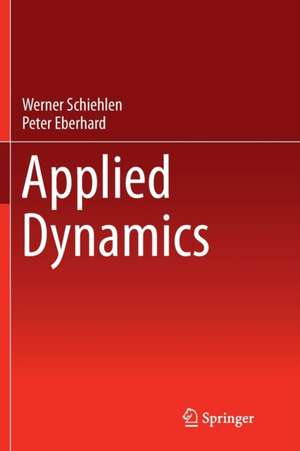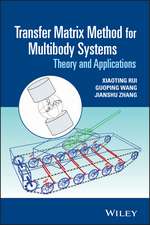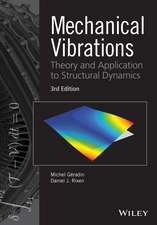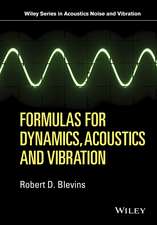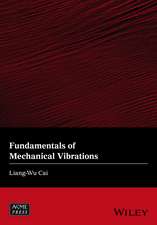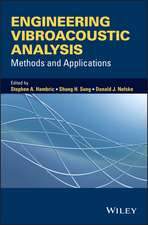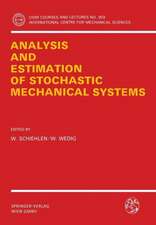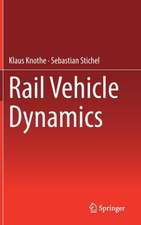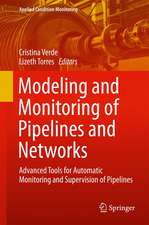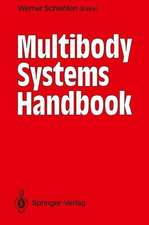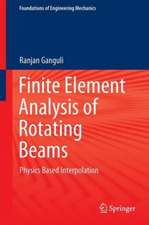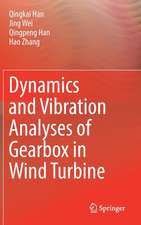Applied Dynamics
Autor Werner Schiehlen, Peter Eberharden Limba Engleză Paperback – 10 sep 2016
| Toate formatele și edițiile | Preț | Express |
|---|---|---|
| Paperback (1) | 384.31 lei 6-8 săpt. | |
| Springer International Publishing – 10 sep 2016 | 384.31 lei 6-8 săpt. | |
| Hardback (1) | 391.61 lei 6-8 săpt. | |
| Springer International Publishing – 19 sep 2014 | 391.61 lei 6-8 săpt. |
Preț: 384.31 lei
Nou
Puncte Express: 576
Preț estimativ în valută:
73.53€ • 76.78$ • 60.72£
73.53€ • 76.78$ • 60.72£
Carte tipărită la comandă
Livrare economică 15-29 aprilie
Preluare comenzi: 021 569.72.76
Specificații
ISBN-13: 9783319374574
ISBN-10: 3319374575
Pagini: 226
Ilustrații: XI, 215 p. 78 illus., 3 illus. in color.
Dimensiuni: 155 x 235 x 12 mm
Greutate: 0.33 kg
Ediția:Softcover reprint of the original 1st ed. 2014
Editura: Springer International Publishing
Colecția Springer
Locul publicării:Cham, Switzerland
ISBN-10: 3319374575
Pagini: 226
Ilustrații: XI, 215 p. 78 illus., 3 illus. in color.
Dimensiuni: 155 x 235 x 12 mm
Greutate: 0.33 kg
Ediția:Softcover reprint of the original 1st ed. 2014
Editura: Springer International Publishing
Colecția Springer
Locul publicării:Cham, Switzerland
Cuprins
From the Contents: Introduction.- Purpose of applied dynamics.- Contribution of analytical mechanics.- Basics of kinematics.- Free systems.- Basics of dynamics.- Dynamics of a point.- Principles of mechanics.- Principle of virtual work.- Multibody systems.- Local equations of motion.- Finite-Elemente systems.- Local equations of motion.- Continuous systems.- Local equations of motion.- State equations of mechanical systems.- Nonlinear state equations.- Numerical equations.- Integration of nonlinear differential equations.
Recenzii
From the book reviews:
“The book is devoted to technical dynamics which has now many applications in science, in mechanical engineering, in transport vehicle and control problems. … The book is addressed to graduate students, engineers and researches.” (Bozhidar Cheshankov, zbMATH 1306.70001, 2015)
“The book is devoted to technical dynamics which has now many applications in science, in mechanical engineering, in transport vehicle and control problems. … The book is addressed to graduate students, engineers and researches.” (Bozhidar Cheshankov, zbMATH 1306.70001, 2015)
Notă biografică
Werner Schiehlen is Professor Emeritus of Mechanics and Past Head of the Institute of Engineering and Computational Mechanics of the University of Stuttgart, Stuttgart, Germany. He has published widely on topics such as multibody system dynamics, nonlinear dynamics, random vibrations, optimization, contact problems, biomechanics, mechatronics, robotics, and vehicle dynamics. He has won many awards and honours and served his field in many capacities in Germany and in the rest of the world. He is one of the Editors in Chief of the Springer journal Multibody System Dynamics.
Peter Eberhard is also a Professor at the Institute of Engineering and Computational Mechanics of the University of Stuttgart, originally studying under Professor Schiehlen. Professor Eberhard also has (co-)authored many works, has international experience, and serves as board member for acclaimed journals.
Together they developed the course material presented here, continually improving and adapting it to new insights and current requirements, first in German, now published in English for a global readership.
Peter Eberhard is also a Professor at the Institute of Engineering and Computational Mechanics of the University of Stuttgart, originally studying under Professor Schiehlen. Professor Eberhard also has (co-)authored many works, has international experience, and serves as board member for acclaimed journals.
Together they developed the course material presented here, continually improving and adapting it to new insights and current requirements, first in German, now published in English for a global readership.
Textul de pe ultima copertă
Applied Dynamics is an important branch of engineering mechanics widely applied to mechanical and automotive engineering, aerospace and biomechanics as well as control engineering and mechatronics. The computational methods presented are based on common fundamentals. For this purpose analytical mechanics turns out to be very useful where D’Alembert’s principle in the Lagrangian formulation proves to be most efficient. The method of multibody systems, finite element systems and continuous systems are treated consistently. Thus, students get a much better understanding of dynamical phenomena, and engineers in design and development departments using computer codes may check the results more easily by choosing models of different complexity for vibration and stress analysis.
Caracteristici
Consistent treatment of multibody systems, finite element systems and continuous systems for better understanding Standardized computer-friendly matrix notation throughout the book for easy readability Educational problems with complete solutions to be used for homework Includes supplementary material: sn.pub/extras
